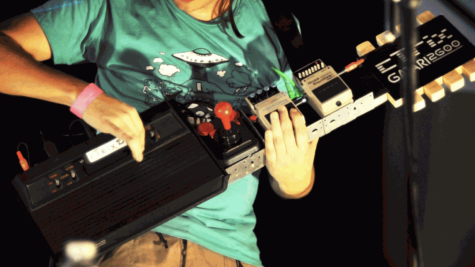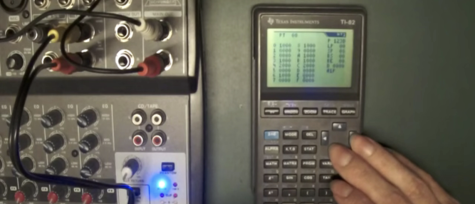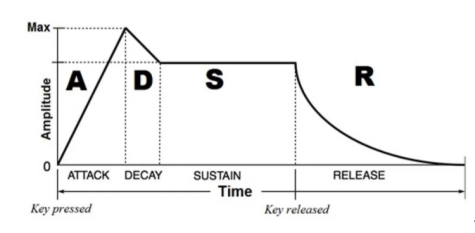What is “Chiptune Music”?
When you hear the word “chiptune,” you might think of an 8-bit procession of blips or the soundtrack to a retro arcade game. Or maybe you’ve never really heard about chiptune music at all. Whatever the case, this article will hopefully fill you in on a little bit about the history and creation of this unique type of music.
Chiptune music derives its name from its original method of production: people would program sound chips in home computers and game consoles to produce a variety of sounds they weren’t originally programmed for, creating tunes with these sound chips, hence the name, chiptune. Chiptune is a method of making music rather than a genre, despite it being often associated with video game original soundtracks (OSTs) or lo-fi electronic sounds. It is also known as 8-bit music because of the sound processors that it was originally made with. Chiptune musicians have even created their own instruments, such as the Gatari, to display on stage or at concerts.

History
Before the use of dedicated sound chips (also known as synthesizers), computer-produced sound was extremely limited. The central processing unit (CPU) in electronic devices was used to process different channels (voices) of sound and relay them to the output device. This severely limited the sounds that computers could produce, usually just to a single type of sound wave, giving the characteristics of beeps and boops of various older computer models.
Dedicated sound chips allowed multiple channels of sound to be broadcasted in different types of waves, such as sawtooth or triangle waves. These chips were able to play multiple types of waves of various frequencies, pitches, and timbres. A sound chip could handle a certain number of channels, for example, five in the NES Gameboy. Each individual channel could handle one of four types of wave: square, sine, triangle, or sawtooth. Another massive innovation in the chiptune scene was the SID. The SID, or sound interface device, was a component of a home computer known as the Commodore 64. Although unable to produce sine waves, this sound chip could process three channels at once, and each channel could produce sawtooth, square, triangle, or noise waves, opening the possibilities for more complex chiptune music. However, there was no easily accessible way to control the sounds produced by a SID. Commodore 64 chiptune musicians not only had to know how to compose music but also knew how to program the computer to produce specific sounds. This is why some of the Commodore 64 musicians such as Martin Galway, Rob Hubbard, and Tim Follin were highly respected for both their technological and musical capabilities in their heyday. Programmable sound generators were another sound chip commonly used in chiptune. These could be found in game consoles, usually for in-game music. Portable game consoles became extremely popular because they had more advanced sound chips than some home computers, as they had a dedicated function to run games with sound, while computers were often designed for more general use with gaming capability.
The Making of Chiptune and Technical Details
Creating chiptune music nowadays can be done through trackers that support different devices and operating systems. A tracker is a type of software for arranging chronological sequences of notes and sounds in order to create music. Trackers can run directly on devices with sound chips or on modern operating software for those who want the authenticity of older sound chips without having access to them. Some trackers compatible with game consoles are in the format of a cartridge in order to run natively on the device. Emulators of older devices won’t always be truly authentic, as some game consoles had pseudo-random noise generators (PRNGs) for their noise channel.


The Attack Sustain Decay Release (ASDR) envelope represents the different stages of individual notes. The attack stage is the increase towards the maximum volume of the note. The decay stage is the transition between the maximum attack volume and the sustain volume. The sustain stage is where the volume of the note is constant, and the release stage is the period in which the note decays into silence.
There are four main types of sound waves that are used in chiptune music. These waves can be modified in frequency and amplitude to produce a variety of notes. Older sound chips could usually only have one wave type per channel. Combined with a set amount of channels, this posed a limit on the complexity of chiptune music. One common strategy used to give the impression of playing more notes than there are sound channels at any given time is to rapidly alternate between different notes in patterns, for example, arpeggios. In addition, different sounds, such as drums or noise, can also be simulated through rapid transitions between different frequencies and wave types in a single channel.
On a Final Note
This is all in stark contrast to the ultra-high quality digital experience of the modern world, where advanced and easy-to-use resources can be found with a little bit of typing and a single left mouse button click. Convenience is ever more accessible and often taken for granted. Despite the many improvements in music production and audio output quality, chiptune has grown from an underground community into a thriving genre more prevalent than ever before. Chiptune concerts are held around the world for some of the most popular artists, with thousands, if not more, flocking to hear songs that they enjoy or feel are nostalgic. Chiptune music has always been about making the most of simple, limited technology and turning it into something creative and original, transforming the ordinary and mundane into something more.
Personal Recommendations
In case you’re somewhat interested in chiptune music, several artists that I would recommend from experience are Kubbi, Danimal Cannon, and Adhesive Wombat. Kubbi has a wider variety of chip genres, while Danimal Cannon leans towards metal and rock, and Adhesive Wombat composes mostly 8-bit music. Their albums and songs aren’t always pure chiptune (especially with Kubbi and Danimal Cannon), which means that you can find certain songs that are within genres or styles you already enjoy with an 8-bit twist.
Alan is currently a sophomore in high school who is interested in aviation. He plays video games and attempts to compose music in his free time.

